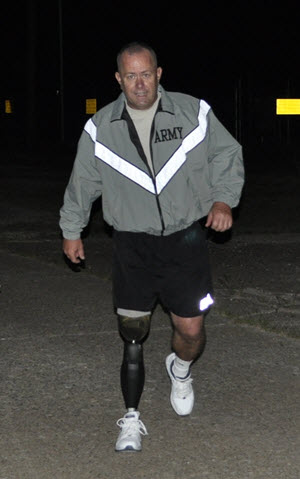Story by: Capt. Esperanza Meza
Posted: March 1, 2015
 (GREENVILLE, Texas) - Despite growing up as an amputee with a prosthetic leg, Pfc. Lonnie Roy, Texas State Guard, always wanted to serve.
(GREENVILLE, Texas) - Despite growing up as an amputee with a prosthetic leg, Pfc. Lonnie Roy, Texas State Guard, always wanted to serve.
Roy grew up watching his father, a retired chief petty officer in the U.S. Navy, serve and spent much of his childhood on military bases. Roy always had a desire to serve, but never could due to his disability.
Roy realized his dream when he graduated Regional Basic Orientation Training and became a Texas State Guardsman Nov. 16, 2014, at the Greenville Armory.
Roy, a Dallas-area resident and director of health systems research at Parkland Health & Hospital Systems in Dallas, was born with a bone disease that led to a leg amputation. After a chance meeting with Sgt. Brian Nail, 19th Regiment, Texas State Guard, Roy learned that his dream of serving might become a reality.
Nail told Roy to look into the State Guard, informing Roy that his disability may be an obstacle but might not be a disqualifier. Roy’s wife was excited and wholeheartedly supported him as she knew he wanted to be in the military his whole life, Roy said.
“Being an amputee, some unique challenges required a little more effort to overcome aside from everyday inconveniences,” said Roy.
During the training, troops received extensive training in land navigation, communications, customs and courtesies, rank structure and chain of command, wear and maintenance of the uniform, a basic leadership course, drill and ceremony and a physical fitness test.
During his training, Roy had to get creative. He learned putting on trousers with a prosthetic leg was difficult due to its three inter-locking pieces. To minimize the time devoted to dressing in the morning, Roy decided it would be easier to pre-dress the leg and lace up the boot and leave it up against his bed roll before going to sleep.
“RBOT was more difficult for me than my fellow trainees,” said Roy, about the training. “Marching presented some unique obstacles for me.”
Marching on uneven surfaces makes it difficult for an amputee to maintain balance. That coupled with keeping in step with his prosthetic leg that seemed to take too long to follow through on the forward step, resulted in Roy falling to the rear.
To fix this marching problem, Roy adjusted his gait, taking 30-inch steps with his leg and 15-inch steps with the prosthetic leg, a suggestion given to him based on how wounded warrior amputees adjusted to marching.
In addition to adjusting to marching with a prosthetic, Roy experienced difficulty in completing the one-mile event on the fitness test, but with some encouragement from fellow service members, he was able to complete it.
“My success was a combination of internal fortitude and fellow soldier’s encouragement providing me the needed motivation,” said Roy. “I am very excited to be part of the Texas State Guard and the Texas Military Forces. I never thought it would be possible to serve in any military force. I hope to continue to serve the State of Texas.”
For those considering the Texas State Guard, but hesitant that a disability may inhibit them, Roy’s message is: "If you are interested in joining, apply and go for it."
Roy is assigned to 1st Battalion, 19th Regiment of the Texas State Guard.